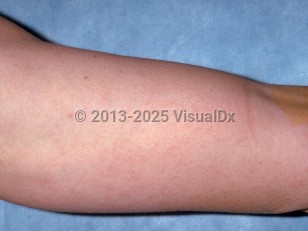Onchocerciasis
Alerts and Notices
Important News & Links
Synopsis

Onchocerciasis, a chronic parasitic disease, is also known as river blindness and sowda. It is caused by Onchocerca volvulus, a tissue nematode transmitted by the black fly (Simulium) in Africa, Latin America, and the Middle East.
Exposure occurs along riverbanks and streams where the black fly vector can be found. The time from infection to evolution of the first skin symptoms is anywhere from 8-20 months after the infective bite. The adult worms reside in subcutaneous nodules where they produce microfilariae for 10 years or more.
Inflammation from the death of the microfilariae leads to intraocular scarring and blindness as well as skin atrophy, loss of elasticity, and hypopigmentation. Nodules located in the head / neck region are thought to be associated with an increased risk of blindness, presumably because of proximity to the eyes. The severity of skin manifestations may be related to parasite burden as well as host immunity. Patients can present with intermittent pruritus, without apparent rash, as their only dermatologic manifestation.
Travel-related infection is rare and is usually associated with long-term travel in rural areas (especially missionaries or researchers). Up to 50% of patients with onchocerciasis in endemic areas develop ophthalmic complications.
In the past few decades, efforts have been made to decrease the burden of onchocerciasis in endemic countries in Africa using ivermectin mass administration. By 2030, onchocerciasis is targeted for elimination in 12 countries by the World Health Organization (WHO).
Pediatric patient considerations: Many initial infections occur in childhood and remain silent for several years. In endemic areas, maternal onchocerciasis infection is a risk factor for children.
Children in endemic regions aged 3-18 years may experience onchocerciasis-associated epilepsy that can present with generalized tonic-clonic, absence, or myoclonic neck seizures.
Exposure occurs along riverbanks and streams where the black fly vector can be found. The time from infection to evolution of the first skin symptoms is anywhere from 8-20 months after the infective bite. The adult worms reside in subcutaneous nodules where they produce microfilariae for 10 years or more.
Inflammation from the death of the microfilariae leads to intraocular scarring and blindness as well as skin atrophy, loss of elasticity, and hypopigmentation. Nodules located in the head / neck region are thought to be associated with an increased risk of blindness, presumably because of proximity to the eyes. The severity of skin manifestations may be related to parasite burden as well as host immunity. Patients can present with intermittent pruritus, without apparent rash, as their only dermatologic manifestation.
Travel-related infection is rare and is usually associated with long-term travel in rural areas (especially missionaries or researchers). Up to 50% of patients with onchocerciasis in endemic areas develop ophthalmic complications.
In the past few decades, efforts have been made to decrease the burden of onchocerciasis in endemic countries in Africa using ivermectin mass administration. By 2030, onchocerciasis is targeted for elimination in 12 countries by the World Health Organization (WHO).
Pediatric patient considerations: Many initial infections occur in childhood and remain silent for several years. In endemic areas, maternal onchocerciasis infection is a risk factor for children.
Children in endemic regions aged 3-18 years may experience onchocerciasis-associated epilepsy that can present with generalized tonic-clonic, absence, or myoclonic neck seizures.
Codes
ICD10CM:
B73.00 – Onchocerciasis with eye involvement, unspecified
SNOMEDCT:
38539003 – Onchocerciasis
B73.00 – Onchocerciasis with eye involvement, unspecified
SNOMEDCT:
38539003 – Onchocerciasis
Look For
Subscription Required
Diagnostic Pearls
Subscription Required
Differential Diagnosis & Pitfalls

To perform a comparison, select diagnoses from the classic differential
Subscription Required
Best Tests
Subscription Required
Management Pearls
Subscription Required
Therapy
Subscription Required
References
Subscription Required
Last Reviewed:01/18/2022
Last Updated:02/17/2022
Last Updated:02/17/2022
Onchocerciasis

